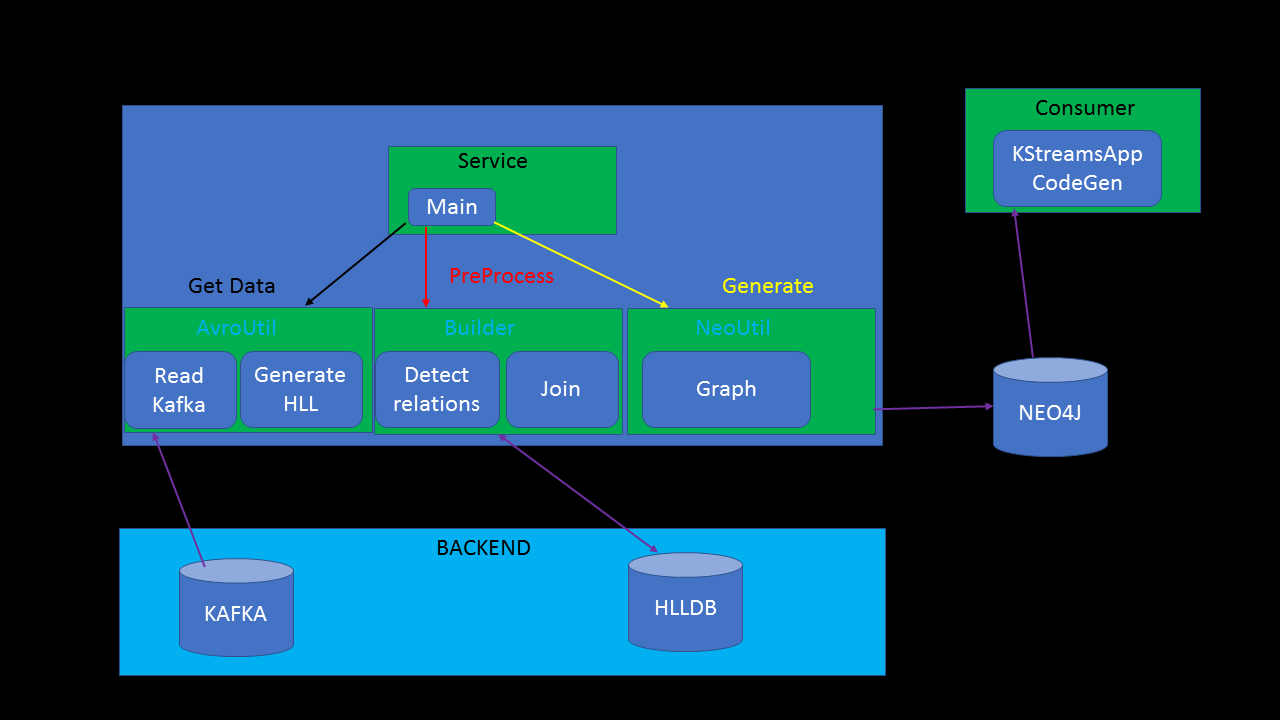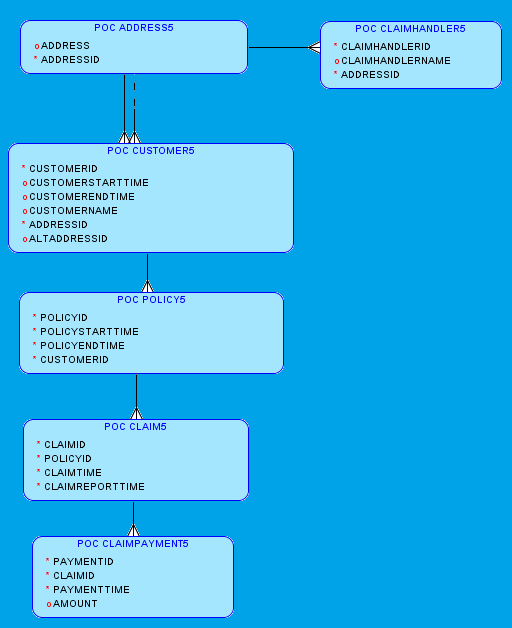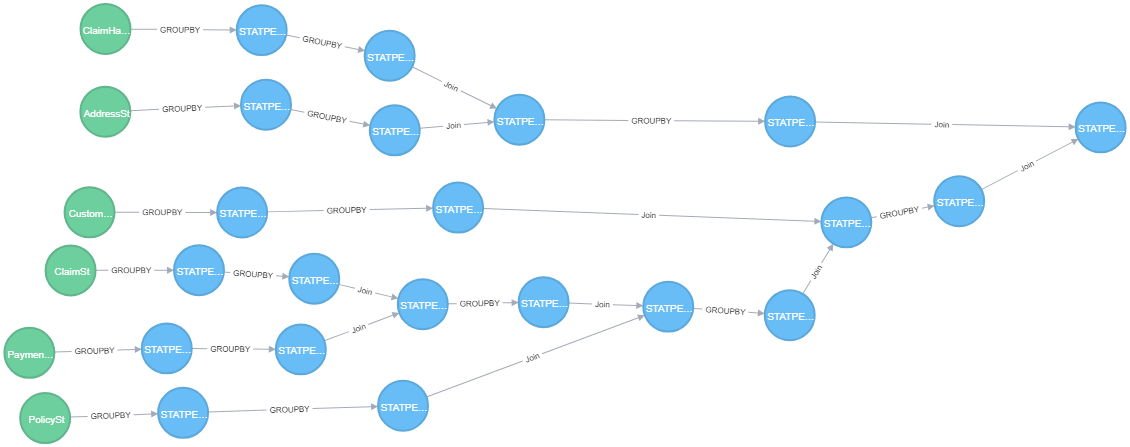This repository contains all documentation and code for generating graphs describing data flow of KStreams data pipelines. It is based on dummy data. The graph is represented as property graph in Neo4j and is used as input for auto generating of ETL pipelines on Kafka.
The dummy data is designed to illustrate a simple data model, describing the claims and payment life-cycle for a customer portfolio. The framework tries to detect entity relationships in the input data. Once that is achieved, it suggests a number of operations like groupBy or join, dictated by the underlying framework of KStreams.
Although the number of entities is limited by the PoC it could potentially be hundreds.
The framework tries to automate series of manual and potentially tedious steps of linking single entities into coherent datasets.
The aim of this project is to demonstrate ability of reading data from variety of Kafka topics, find the underlying relationships between these entities and join them into coherent KTables, used by analytical services.
For the purpose of entity relationships detection we use HyperLogLog(HLL) algorithm. HLL is an algorithm for the count-distinct problem, approximating the number of distinct elements in a set.
Application is written in Java and requires Java8.
Schema registry repo URL is set in ConfluentBasedSchemaRegistry.java .
public ConfluentBasedSchemaRegistry(AttunityMessageDecoder messageDecoder) {
this.decoder = messageDecoder;
this.schemaRegistryBean = new ConfluentSchemaRegBean();
this.schemaRegImpl = new ConfluentSchemaRegistryHandlerImpl();
this.schemaRegistryBean.setRepoURL("http://10.84.0.5:8081");
}
Kafka related properties in KafkaUtilities.java .
public static Properties getKafkaProducer1Properties() {
Properties properties = new Properties();
properties.put("bootstrap.servers",
"wn0-kaf001.si34agdvrydetneynufspu4j5a.fx.internal.cloudapp.net:9092,wn1-kaf001.si34agdvrydetneynufspu4j5a.fx.internal.cloudapp.net:9092,wn2-kaf001.si34agdvrydetneynufspu4j5a.fx.internal.cloudapp.net:9092,wn3-kaf001.si34agdvrydetneynufspu4j5a.fx.internal.cloudapp.net:9092");
properties.put("key.serializer", "org.apache.kafka.common.serialization.StringSerializer");
properties.put("value.serializer", "org.apache.kafka.common.serialization.StringSerializer");
return properties;
}
Source Kafka topics in HLLDB.java. For version 5 of data the topics are as follows:
public static final String CUSTOMER_TOPIC ="STATPEJ.POC_CUSTOMER5";
public static final String POLICY_TOPIC ="STATPEJ.POC_POLICY5";
public static final String CLAIM_TOPIC = "STATPEJ.POC_CLAIM5";
public static final String PAYMENT_TOPIC = "STATPEJ.POC_CLAIMPAYMENT5";
public static final String ADDRESS_TOPIC = "STATPEJ.POC_ADDRESS5";
public static final String CLAIMHANDLER_TOPIC = "STATPEJ.POC_CLAIMHANDLER5";
Noe4j properties in NeoUtils.java .
Driver driver = GraphDatabase.driver(
"bolt://localhost:7687", AuthTokens.basic("user", "password"));
Session session = driver.session();
Modules and processes
An arbitrary sample of data is read from Kafka in Avro format. Base on tha data a number of
HLL objects are generated. Classes responsible for that workload are located in src/main/java/com/nereus/avro
package.
Input from AvroUtils module is passed to Builder class that has only two tasks. Detecting entity relationships and suggesting plausible joins.
Based on the metadata in the backend, a graph is genereated, as input for Kstreams applications generator.
HLLDB is currently stored in bunch of static variables in memory, but it really makes sense to create a proper backend solution like for example Postgres. It will add traceability and transparency to the process of generating graphs.
The programm attempts to embrace functional programming paradigm and ideas from "Clean Code: A Handbook of Agile Software Craftsmanship by Robert C. Martin"
Functions are intentionally kept "pure" meaning that they don't have side-effects. They can be written, tested, reasoned about and debugged in isolation, without the need to understand external context or history of events surrounding its execution.
Pure task, contrarily to a pure function is typically not returning anything. They should be deterministic and idempotent, meaning that they will produce the same result every time it runs or re-runs. Rexecuting a pure task with the same input parameters should overwrite any previous output.
Parallelization, however is not considered in the scope this PoC. Pure tasks should be implemented in a way that instances don't interfere with each other.
Instead of creating a overly complex program that solves a given problem perfectly but is hostile towards any changes in the future, the framework tries to anticipate the necessity of modification and replacing of the modules.
Some of principles used:
Functions
- Must be small (ideally max 20 lines)
- Should do only one thing
- Should not have side effects
- Should respect Command Query Separation(Functions should either do something or answer something, but not both)
Reproducibility
- Immutable data(append-only) along with versioned logic
- Pure tasks
Version 5 of data consists of 6 entities.


